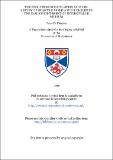Files in this item
The evolution of population III stars: a study of selected models with regard to the early enrichment of the interstellar medium
Item metadata
| dc.contributor.advisor | Carson, T. R. (Thomas Richard) | |
| dc.contributor.author | Thacker, Peter D. | |
| dc.coverage.spatial | 303 p. | en_US |
| dc.date.accessioned | 2018-06-20T10:11:45Z | |
| dc.date.available | 2018-06-20T10:11:45Z | |
| dc.date.issued | 1996 | |
| dc.identifier.uri | https://hdl.handle.net/10023/14308 | |
| dc.description.abstract | Modelling of the evolution of 15M[sub]sun, 10M[sub]sun, 5M[sub]sun arid 2M[sub]sun stars has been carried out at three different initial compositions that could be thought of as 'population III' - Z=10⁻¹⁰, 10⁻¹⁰ and zero. The effects of mass loss due to a stellar wind have been included in the modelling, the mass loss rates taken from an empirical formula by Nieuwenhuijzen and de Jager (1990). An original and amended form of a FORTRAN 77 quasi-hydrostatic evolutionary code, written by Dr. T. R. Carson and modified by the author of this work, were used to create and evolve the models. The aims of the evolutionary modelling were to confirm that the sensitivity of stellar parameters to the initial metallicity of a star continues to a lower level of Z than has previously been thought, and to provide some evidence that nucleosynthesis and subsequent mass loss in a population III is a plausible mechanism for the prompt enrichment of the early interstellar medium. We find that there is sensitivity of stellar parameters to the initial metallicity Z in the range 0≤Z≤10⁻¹⁰ but this is less apparent in models of intermediate or low masses. During the evolution of the models, no significant loss of enriched material occurs, due to low rates of mass loss and the absence of any 'dredge-up' of enriched material. The results of the modelling were connected with bare-core studies of helium stars to determine the amount and composition of the material that would be returned to the interstellar medium during the endstates of the models. Functions for the rates of enrichment due to a population III and the distribution of mass in a population III were determined and their implications examined. From our results, we find that the enrichment of the interstellar medium due to population III stars must have come about entirely due to rapid mass loss during endstates, such as supernovae, as opposed to a slower rate of mass loss during the lifetime of the stars. We also find that our results indicate that the level of helium enrichment from a population III would be negligible compared to that due to cosmological mechanisms. Our distribution functions for a population III indicate that massive stars are very much fewer by number that would be expected for stars in our epoch. Overall, we can consider that a primordial population III can be considered a plausible mechanism for a prompt enrichment of metals in the early universe, but not for the prompt enrichment of helium. | en_US |
| dc.language.iso | en | en_US |
| dc.publisher | University of St Andrews | |
| dc.subject.lcc | QB806.T2 | |
| dc.subject.lcsh | Stars--Evolution | en |
| dc.title | The evolution of population III stars: a study of selected models with regard to the early enrichment of the interstellar medium | en_US |
| dc.type | Thesis | en_US |
| dc.type.qualificationlevel | Doctoral | en_US |
| dc.type.qualificationname | MPhil Master of Philosophy | en_US |
| dc.publisher.institution | The University of St Andrews | en_US |
| dc.publisher.department | Department of Physics and Astronomy | en_US |
This item appears in the following Collection(s)
Items in the St Andrews Research Repository are protected by copyright, with all rights reserved, unless otherwise indicated.

